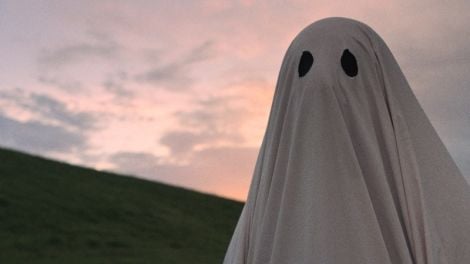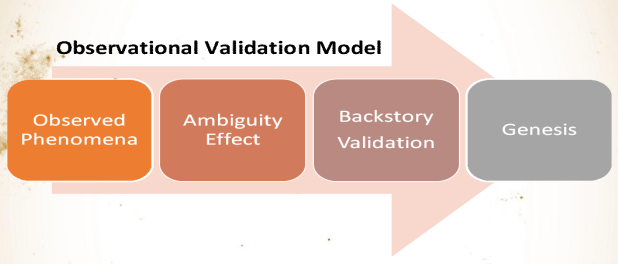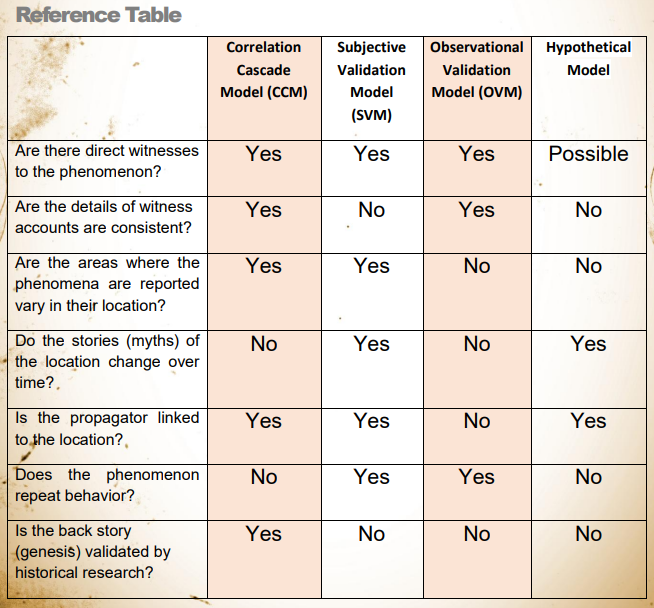Logic proves that ghosts are exceedingly unlikely to be the cause of a phenomenon. The thousands of supposed ghost cases have turned out to have very reasonable explanations. Many reports from past psychical researchers and parapsychologists indicate that 9 out of 10 ghost-related cases are solvable when someone has actually looked deeper than the surface for explanations.
Most hauntings and cases of ghostly phenomena are simply nothing more than ghost stories, myths that have been circulated that may or may not have been believed by their tellers to be true.
How these myths develop and how they are propagated vary greatly. Generally speaking, they can be broken down into four basic models. The identification of a particular model can dramatically improve the odds of successfully solving the mystery presented by the myth. These four models are listed below with their identifying characteristics and tips on how to investigate them.
Correlation Cascade Model
This model begins with a single event or circumstance (Genesis) that initiates the myth-building. This event can vary from an initial account of a single witness, the morbid history of a location, or the sole fact that a particular place has a grim or mysterious appearance and looks “haunted.”
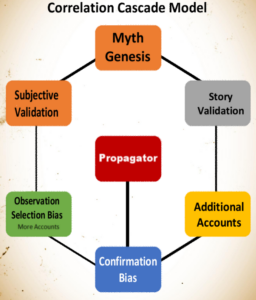 Additional witness experiences are then assimilated into the myth by inaccurately perceiving a relationship between the unrelated events and the genesis. This creates an illusion of validity (Story Validation) and a preconception that the unusual experiences are paranormal in origin.
Additional witness experiences are then assimilated into the myth by inaccurately perceiving a relationship between the unrelated events and the genesis. This creates an illusion of validity (Story Validation) and a preconception that the unusual experiences are paranormal in origin.
More witnesses search for, interpret, and focus on information in a way that conforms to the myth’s preconceptions (Confirmation Bias). This primes the location for additional “paranormal” experiences by creating an observation selection bias.
Biased by the knowledge of the myth, people start noticing things that were not seen previously and, as a result, wrongly assume that this newly discovered phenomenon is paranormal in origin (Observation Selection Bias).
In this model, the propagator is often directly associated with the location in some fashion. They could be the owners or managers of the site, a tour guide, or perhaps an employee. It could also be an entity like the staff of a particular business. They propagate the myth by disseminating information to guests, the media, and other people who visit the location.
These visitors have been biased, and if the person’s belief is open to the existence of paranormal phenomenon, their perception creates an increase in the possibility of misinterpreting a regular event as a paranormal oriented one (Subjective Validation Bias). This, in turn, creates additional events that give the myth longevity.
Key Identification Features:
- The genesis is based on the interpretations of a few witnesses. These will be the most detailed accounts and will typically appear very early in the myth’s history. Additional statements will be vague and have apparent alternative explanations that were not even considered by the witnesses due to subjective validation bias. While it is essential to identify this bias in the later accounts for further investigation, the focus should be on the initial accounts to attempt to uncover the genesis.
- Many of the witnesses ‘ stories will be second or third-hand accounts.
- The first accounts will show signs of the Anchoring Effect. This is the tendency to rely too heavily upon, or “anchor,” on one trait or piece of information. Usually, this is the first piece of information that was acquired on that subject.
- The propagator is connected to the location in some way. Without the propagator, the myth lacks longevity. Typical things to look for are mentions of the myth in pamphlets, brochures, and other printed media that is distributed by the propagator. Mentions may also be found on the location’s website, mentioned on local tours of the area, or on television shows about the myth where the propagator is interviewed.
- The reported phenomenon does not appear to repeat behavior. Instead, it seems to be completely random in frequency and consists of random events and occurrences.
- Subjective validation causes the elements of the myth to be replicated and condensed. For example, a myth may indicate that people smell a foul odor in a spot where a person was known to have died. The myth makes it sound like this is a collective experience that has happened to several people. In reality, it only occurred once to a single person. Also, the storytelling of the myth will condense experiences that have happened over a period of time and make it sound like those occurrences happened at the same time in a single event or suggest that the phenomenon repeating and happening to more people than it actually is. The areas where phenomena are reported will vary greatly.
- This model is a cycle. It feeds itself through the dissemination of the myth by the propagator and additional reported events that are believed to be paranormal in origin.
Investigation Tips
The focus of the investigation should be placed on the initial accounts to attempt to uncover the genesis.
Check the validity of the back story against historical accounts and search for changes to the back story.
Replicate environmental factors so that they are constant with the environment when the witness had their experience. Observe and search for alternative explanations for the reported phenomenon. Replicate the phenomenon to prove the alternative hypothesis.
Subjective Validation Model
The SVM model starts with a genesis event where the preconceptions that the unusual experiences are paranormal are quickly established and sustained by the witnesses’ confirmation bias. The illusion of validity is created, and the myth starts to grow through subjective validation.
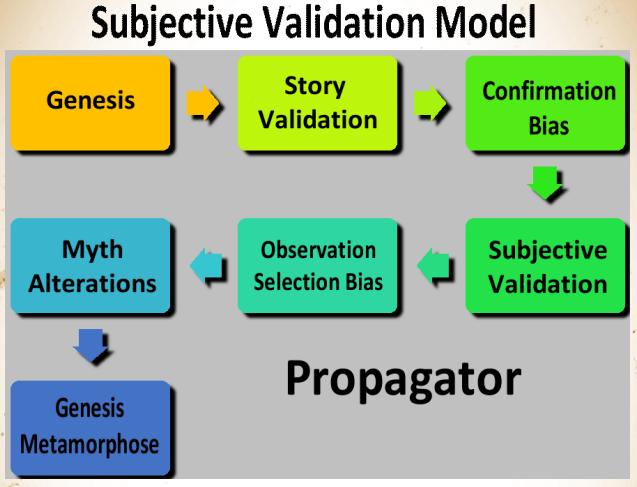 Guests and visitors are biased by the myth. If the person’s belief is open to the existence of paranormal phenomenon, their perception creates an increase in the possibility of misinterpreting a typical event as a paranormal oriented one. They also start noticing things that were not seen previously and, as a result, wrongly assume that this newly discovered phenomenon is paranormal in origin (Observation Selection Bias).
Guests and visitors are biased by the myth. If the person’s belief is open to the existence of paranormal phenomenon, their perception creates an increase in the possibility of misinterpreting a typical event as a paranormal oriented one. They also start noticing things that were not seen previously and, as a result, wrongly assume that this newly discovered phenomenon is paranormal in origin (Observation Selection Bias).
In the SVM model, this new information is taken as fact and is added to myth, often replacing the older ideas with the newly discovered ones. This causes alterations in the myth, particularly in the back story (genesis), and creates a “new” phenomenon. This will often manifest as “additional ghosts” and other types of phenomenon being added to the genesis.
Myths of this type are often hard to solve because the genesis is changing over time, obscuring the facts needed to seek alternative explanations for the phenomenon.
Key Identification Features:
- The genesis will form from a single event. Additional information is then provided to support the genesis (Illusion of Validity)
- The propagator is often the location itself but will be supported by other sources.
- The stories (myths) of the location change over time. This is particularly true for the stories surrounding the genesis. Historical research of the stories is vital.
- The reported phenomenon may repeat behavior, but the causes of this “paranormal activity” may change and morph with alterations to the genesis.
- There will be a high degree of myth-building. The myth has probably been featured on television shows, in multiple books and newspaper articles. The legend is very well known.
- The location is believed to have a high degree of “paranormal activity” as the subjective validation of visitors who are constantly generating new events that are believed to be paranormal.
- Details in the accounts from the witness will vary greatly. For example, one may describe an apparition wearing a green shirt while another claims that it was red. There are too many variations in the details that suggest the witnesses could be misperceiving a quasi-normal event or not seeing the same thing.
- The areas where phenomena are reported will vary greatly.
- Many of the witnesses’ accounts may be second or third-hand accounts.
Investigation Tips
Focus on the historical investigation of the back story. Check the validity of the back story against historical accounts and search for changes to the back story.
Replicate environmental factors so that they are constant with the environment when the witness had their experience. Observe and search for alternative explanations for the reported phenomenon. Replicate the phenomenon to prove the alternative hypothesis.
Observational Validation Model
OVM model is based on an actual phenomenon that was observed by multiple people. Unable to identify what the phenomenon is, the witnesses believe that the phenomenon is paranormal in nature, which results in the Ambiguity effect. This is the tendency to avoid options for which missing information makes the probability seem “unknown” and thus “paranormal.”
The myth is created when a “back story” is offered to attempt to explain what the phenomena is (how or why it is paranormal). This will often involve a piece of history or maybe wholly fabricated. With the witness accounts and the back story complete, the genesis is formed for the myth.
Key Identification Features:
- The genesis relies on an observable phenomenon.
- Details of the direct witness accounts will be similar in their description.
- Event(s) reported by witnesses will always be in the same area(s).
- Many of the witness accounts may be second or third-hand accounts.
- The back story to the myth may be fabricated. This can be identified through historical research.
Investigation Tips
Focus the investigation on identifying the nature and cause of the observable phenomenon.
Hypothetical Model
This model is formed off of characteristics of a location that creates the assumption that it must be haunted. For example, a deserted hospital has had many deaths that occurred within it, so it must be haunted by some of the deceased people. Hypothetically, it should be haunted.
Subjective Validation is created by several causes. These include pranks, hoaxes, and information from unreliable sources such as psychics, mediums, paranormal investigators, urban explorers, and material from the internet. This, in turn, creates a clear belief bias that the location is haunted or is “paranormally active.” Once these parts have been put together, it creates an illusion of validity. However, this illusion is often subject to the focusing effect. This effect is the tendency to place too much importance on one aspect of an event. Usually, this will be the story that is the most spectacular. When confronted with alternative explanations, this is the element that you will be rebutted with.  This process creates the genesis.
This process creates the genesis.
Key Identification Features:
- Details of the witness accounts will vary significantly in their description. These accounts are very subjective to the bias of the observer.
- The areas where phenomena are reported will vary greatly.
- The back story to the myth may be fabricated. This can be identified through historical research.
- Most of the witness experiences will be second or third-hand accounts.
- The elements of the myth may change over time.
- New phenomenon, additional “ghosts,” maybe created later in the process due to rampant myth-building.
- The reported phenomenon does not repeat behavior.
Investigation Tips
Focus on the historical investigation of the back story. Check the validity of the back story against historical accounts and search for changes to the back story.
How to use the myth models.
Investigating a paranormal claim is a lot like building a puzzle you would find in a second-hand store. It has a few missing pieces and perhaps a few additional ones from another puzzle altogether. The myth models were designed to help you find the edges and corners of the puzzle and to help identify any missing pieces.
To use the myth models, simply consider the seven questions listed in the chart on the previous page. Once you have selected a possible model that fits, use the key identification features and investigation tips to locate the missing pieces required to identify any hidden variables, and prove your hypothesis.
So what happens if the criteria for a haunting are actually met?
This simply means that the phenomena can be considered high-grade and worthy of further investigation. This is where the longitudinal study begins.
This requires repeated visits to the location to monitor any changes and to address further paranormal claims. It is essential to document everything as thoroughly as possible, noting specific details such as the type of apparition, the characteristics it seems to display (according to the witnesses), the conditions at the time it was seen. Pay close attention to any details that may suggest a pattern (e.g., whether it only appears at certain times of the day or in a specific area?).
Documentation through audio or video recording can be quite helpful so that more information is not lost and can be double-checked later on.
Publish your findings and raw data on the internet and invite other people to analyze, including parapsychologists and members of the skeptical community.
If the continued investigation is still unable to identify alternative explanations, you may be able to make a case that something unusual is indeed occurring at that location. However, this is a far cry from claiming that it is haunted or that paranormal phenomena are actually happening. That determination will ultimately be up to professionals in various scholarly fields.
